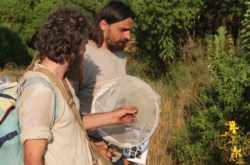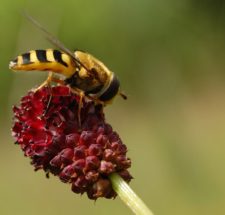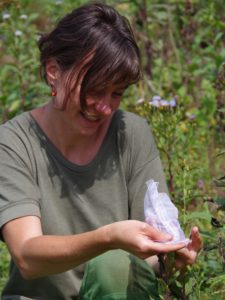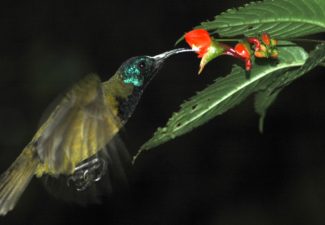In pollination ecology we collaborate very closely with Štěpán Janeček, Michael Bartoš and other researchers from the Institute of Botany, Czech Academy of Sciences. Currently, our pollination research is supported by two grants from the Czech Science Foundation and a grant from the Grant Agency of the Charles University.
Plant-pollinator interactions represent the main force in angiosperm and insect diversification. During more than ten years of research of pollination systems in strongly understudied Afrotropical mountains, we have aimed to look for details of the plant-animal interactions. We focus on the networks from many different points of view. We also apply different field techniques to uncover functioning of various pollination systems and patterns behind them. Recently, we have broadened our pollination interests into the temperate zone, starting a larger project in the Železné hory Mts., Czech Republic.

Patterns of pollination networks along environmental gradients

Currently, our main field of interest is how relationships between flowering plants and their visitors change with various environmental conditions. Surprisingly, changes in these interactions on the community level are virtually unknown even along such well-studied gradients as altitude or isolation. At the moment, we focus on two quite different systems. On Mount Cameroon, we study changes of pollination networks along the elevational gradient. Mt. Cameroon is unique, since it is the only mountain with primary tropical forest from the shore to the timberline in the whole continent. In the Zelezne hory Mts., central Czech Republic, we aim to reveal how pollination networks in wet meadows are affected along a gradient of the meadows’ isolation. Although the main questions of these two projects differ, we are using similar main approaches.
On Mt. Cameroon we focus mainly on plants potentially visited and pollinated by Lepidoptera (both butterflies and moths) and sunbirds. The main part of our data is based on video recording of all focal plant species along the elevational gradient, allowing us to observe the behaviour of various visitors without disturbing them, which is important for better understanding their roles in pollination systems of individual plants. It also allows for more efficient covering of numerous flowers present, even during difficult conditions, such as night, rain or flowers within tree canopies. Simultaneously, we are trying to add the “opposite site” of the network and we started with the development of metabarcoding of pollen carried by both Lepidopterans and birds. Furthermore, we measure various traits of both flowers and visitors to reveal any potential patterns along altitude. In all aspects of the project, we have a big advantage of data on butterflies and moths from our other projects, as well as data on plants and sunbirds from projects of Štěpán Janeček.


The project in the Železné hory Mts. (led by Michael Bartoš) generally aims to reveal what biotic filters can exclude various plant species from isolated meadows. Since 2016, we have collaborated mainly on uncovering how habitat fragmentation affects pollination networks and how plant communities can be shaped by interactions with visitors of their flowers. Besides video recording of all common plant species flowering on the studied meadows, we also systematically collect visitors on flowers. This is necessary to obtain a more accurate identification, since identification using video recordings can be rather difficult. Catching and exact identification of insect visitors will also allow us to include their morphology and traits into our research questions. We can built on data from plant communities on both local and regional level from a long-term project of Štěpán Janeček and his colleagues, however no detailed research of any insect group from the region exists so far.
Detailed view into individual pollination systems

In the poorly studied Cameroonian mountains, we focus on details of various pollination systems to better understand the complete local communities, as well as to improve general methodological approaches in pollination biology. With a few detailed studies of different plant species, we uncovered roles of individual animal visitors in plant reproduction, and vice versa. In general, a majority of animal-pollinated plants are believed to have a relatively high diversity of pollinators. Our case studies are repeatedly showing that, although we recorded a relatively high diversity of visiting species, only a small share of them can pollinate them efficiently. A vast majority of visitors do not contribute to plant pollination at all. Quite some of them even cheat and steal the flower rewards without paying back through pollination. It counts for many relatively specialised plants, such as Hypoestes aristata with the bee pollination syndrome, as well as for at least some morphologically generalised flowers, such as Hypericum roeparianum and H. revolutum with easily accessible large yellow flowers. Such results are also interesting for the pollination research methodology, as many community-wide studies do not consider the true role of the floral visitors and consider all animals present on a flower as pollinators. Our results contribute to general doubts on such studies’ results.
Within the studied pollination systems we focus also on a few more specific aspects, such as interactions between individual flower visitors, or complementarity of various traits of flowers and animals. Precise understanding of intraspecific interactions among flower visitors are crucial in revealing mechanisms behind evolution of pollination systems, including their general patterns, as well as the relationships within the whole communities. The competition for nectar, especially among distantly related animals, is one of the most important relationships between flower visitors in pollination systems. As an example, we experimentally suggested that carpenter bees, as the smaller pollinators, are competitively superior to sunbirds, as the bigger nectar thieves, due to their smaller energy requirements and ability to explore less abundant resources ofHypoestes aristata. Nevertheless, the sunbirds “pay back” by using the nectar resources when their bee “rivals” are not active, faster nectar consumption, and even by aggressive exclusion of the carpenter bees from the nectar source.

Specialized sunbird-pollination systems
Since several of our group members started within pollination ecology under the leadership of Štěpán Janeček, we have been (and still are) specifically focusing on sunbirds as pollinators. The nectarivory of sunbirds in the Old World and hummingbirds in the New World evolved independently, but much higher research effort has been invested into hummingbirds. Although there is intensive research of sunbirds in southern Africa, studies from the Afrotropics, where the majority of sunbird diversity occurs, are still quite rare. We are trying to fill this gap, focusing mainly on relatively highly specialised relationship with Impatiens plants (although we are currently focusing on some other systems on Mt. Cameroon as well) and on interactions between sunbirds and insects in more generalised plant species.

While the feeding apparatus adaptations of the two groups appear to be very similar, it is believed that they strongly differ in other adaptations, mainly related to a hovering flight. Numerous New World pollination systems of plants specialised for hummingbirds often manifest adaptations for their hovering flight, e.g. absence of a perch, long floral pedicels and peduncles, or highly precise placement of pollen on birds’ bodies. On the other hand, Old World systems are usually considered to be adapted to the perching behaviour of not so specialised bird pollinators. We have been collaborating on a discovery of the first known Old World pollination system of Impatiens sakeriana plant and Cameroonian Sunbird (Cyanomitra oritis) being co-evolved to hovering of the bird pollinator.

Comparable to highly specialised hummingbird plants, I. sakeriana has red tubular flowers on long peduncles oriented into free space, and even nectar properties similar to those pollinated by hummingbirds. Moreover, results of a detailed experiment on the plant traits eliciting the hovering behaviour did not support suggestions that sunbirds prefer to sit whenever possible. We thus infer that the sunbird’s preference to perch or hover during its feeding is as much a question of the plant architecture as of an optimal foraging. Together with the botanists, we still continue in studying other aspects of potential specialisations of sunbirds and flowering plants.
